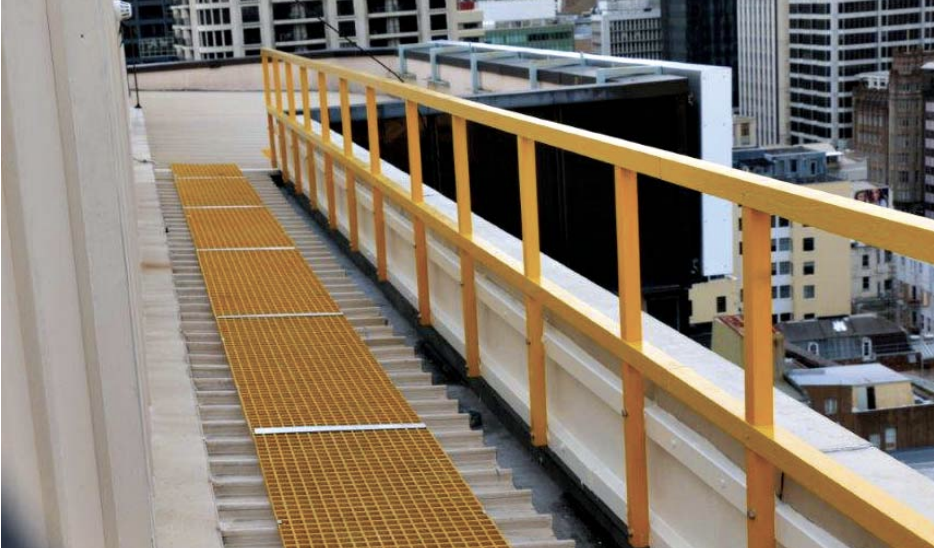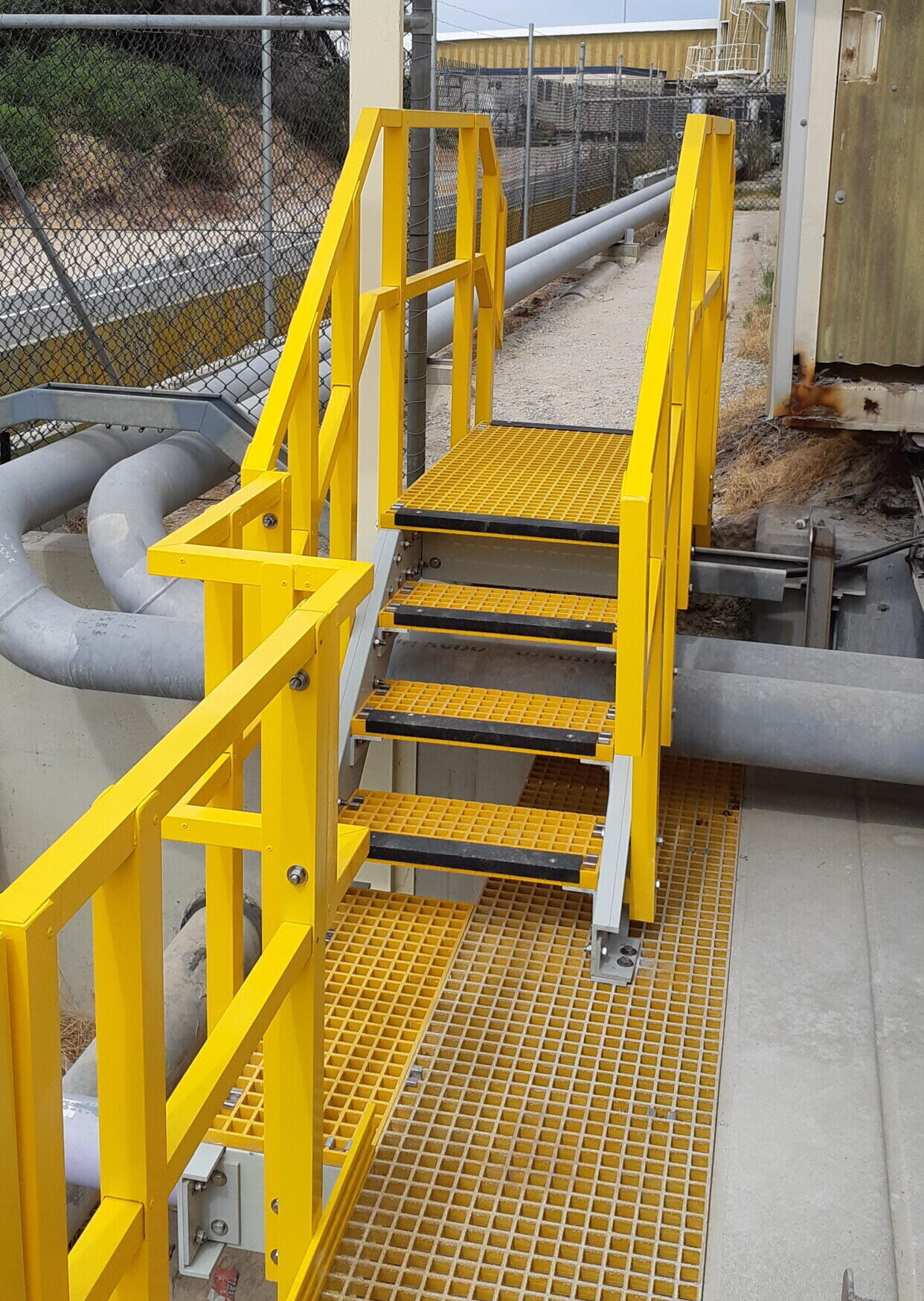In harsh industrial environments, worker safety and accessibility are essential for operational efficiency.
FRP Engineering delivers tailored composite solutions designed to meet these challenges. A notable example is the design, construction, and installation of an FRP platform with an integrated step ladder, specifically engineered to endure tough industrial conditions. The client’s operational site faced challenges such as corrosion, confined spaces, and the need to integrate the new structure with existing equipment, requiring a durable, efficient solution.

Addressing Safety Concerns
Before the installation of the FRP platform and step ladder, the client’s workers faced significant risks in accessing critical machinery. The existing environment was characterised by:
- Corrosion: Traditional materials such as metal were prone to rusting in the harsh industrial conditions, compromising structural integrity.
- Confined Space: The area where the equipment was located was tight, limiting the ability to install large, conventional access solutions.
- Unsafe Access: Workers were required to navigate narrow spaces and uneven surfaces to reach equipment, which posed significant safety risks.
The need for a solution that could provide stable, safe access without compromising on durability or performance was clear. FRP Engineering was approached to address these issues with a custom-designed platform and stepladder.
A Custom-Built FRP Platform and Step Ladder
FRP Engineering’s solution involved the design and fabrication of a custom FRP platform with an integrated stepladder. This solution was specifically tailored to meet the client’s operational needs while ensuring compliance with Australian safety standards. The key aspects of the solution included:
- Designing for Harsh Conditions: The design process began by considering the unique challenges of the client’s site. FRP Engineering used its local knowledge and expertise in composite materials to create a platform and stepladder that could withstand extreme conditions such as corrosion, heavy foot traffic, and limited space. The structure was designed to fit seamlessly with the existing equipment, ensuring that it met both operational and safety requirements.
- Ease of Installation: One of the primary benefits of using FRP in this project was the ease of installation. The entire platform and stepladder were fabricated in FRP Engineering’s Canningvale factory, reducing the amount of work required on-site. The finished product was delivered, dismantled, and installed in just one afternoon with minimal disruption to the client’s ongoing operations. This efficient process not only saved time but also ensured that worker safety was enhanced quickly.
- Corrosion Resistance: The FRP platform and stepladder were designed with corrosion-resistant materials that would stand up to the challenging conditions of the industrial environment. The use of FRP grating, stair treads, and handrails ensured that the structure would maintain its integrity over time, even in areas exposed to moisture and harsh chemicals. FRP’s resistance to corrosion significantly reduced the need for ongoing maintenance, providing a long-term solution that was both cost-effective and durable.
- Safety and Convenience: The addition of a stepladder to the platform enhanced access to high or hard-to-reach areas, reducing the need for workers to use makeshift solutions like ladders or scaffolding. This not only improved worker safety but also increased efficiency by providing a dedicated, stable access point. The non-slip surface of the FRP grating ensured that workers could safely access the platform even in wet or slippery conditions.
A Safer, More Efficient Workspace
The installation of the FRP platform and step ladder provided several key benefits to the client, particularly in terms of safety, efficiency, and long-term durability. Some of the key results included:
- Improved Worker Safety: The custom FRP platform and step ladder created a stable, slip-resistant surface for workers to navigate, reducing the risk of trips and falls. The structure provided safe, easy access to the equipment, preventing the hazards associated with using unsafe or makeshift ladders.
- Corrosion Resistance: The FRP materials used in the design of the platform and stepladder ensured that the structure would withstand the harsh environmental conditions without deteriorating over time. This corrosion resistance made the platform a more reliable and cost-effective solution compared to traditional metal platforms that would require frequent maintenance or replacement.
- Increased Efficiency: By providing a dedicated access point with an integrated step ladder, workers were able to complete their tasks more efficiently. The ease of installation further minimised downtime and disruptions to ongoing operations, ensuring that the client’s site could continue to function smoothly without extended interruptions.
- Custom-Built Solution: The platform and step ladder were designed to fit seamlessly into the existing infrastructure, addressing the unique challenges posed by the confined space and existing equipment. The bespoke design meant that the solution was tailored specifically to the client’s needs, ensuring that all safety standards and operational requirements were met.

The FRP Approach: A Comprehensive Process
At FRP Engineering, we take a systematic approach to every project to ensure that the final solution meets the client’s needs and adheres to all relevant safety and quality standards. The process for this project included:
- Understanding the Problem: The first step in our approach was to gain a comprehensive understanding of the client’s needs. The FRP team took time to discuss the project’s challenges and specific requirements, including the need for a corrosion-resistant solution, the confined space, and the integration with existing equipment.
- Designing the Solution: Based on the initial consultations, the team designed a custom solution that addressed all of the client’s concerns. We used our expertise in composite materials to create a durable, cost-effective, and safe solution that would meet Australian safety standards.
- Testing, Delivery, and Installation: After the platform and step ladder were constructed, they underwent rigorous testing to ensure that they met all safety and performance standards. Once tested, the structure was disassembled, delivered to the site, and installed in a single afternoon with minimal disruption to the client’s ongoing operations.
FRP Products Used
The following FRP products were essential to the success of this project:
- FRP Grating: Used for the platform surface, providing a non-slip, durable surface that can withstand harsh conditions.
- FRP Stair Treads: Designed for safe, stable access to the platform.
- FRP Profiles: Used for structural integrity and to provide a solid foundation for the platform.
- FRP Handrails: Installed for added safety, ensuring that workers could navigate the platform with confidence.
The successful installation of the FRP platform and stepladder has not only enhanced worker safety but also provided a long-term solution to the client’s access challenges.
By leveraging FRP Engineering’s expertise in designing tailored composite solutions, the client now has a durable, corrosion-resistant, and easy-to-maintain access structure that meets all safety requirements. This project demonstrates the significant advantages of using FRP in industrial environments, where safety, durability, and cost-effectiveness are key priorities.

